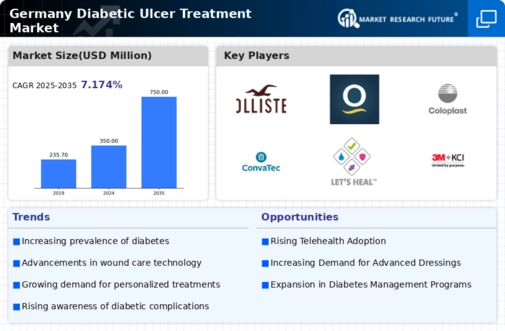Rising Healthcare Expenditure
Germany's rising healthcare expenditure is a significant driver for the diabetic ulcer-treatment market. The country allocates a substantial portion of its GDP to healthcare, with expenditures reaching approximately 11.7% in recent years. This financial commitment facilitates the availability of advanced treatment options for diabetic ulcers, as healthcare providers are better equipped to invest in innovative therapies and technologies. Additionally, increased funding for diabetes management programs and wound care initiatives further supports the growth of the diabetic ulcer-treatment market. As healthcare budgets continue to rise, the market is likely to benefit from enhanced access to effective treatment solutions for patients suffering from diabetic ulcers.
Growing Prevalence of Diabetes
The increasing prevalence of diabetes in Germany is a primary driver for the diabetic ulcer-treatment market. As of recent data, approximately 7.5 million individuals in Germany are diagnosed with diabetes, leading to a heightened risk of complications such as diabetic ulcers. This condition necessitates effective treatment options, thereby expanding the market for advanced wound care products. The diabetic ulcer-treatment market is projected to grow as healthcare providers focus on managing diabetes-related complications. Furthermore, the aging population, which is more susceptible to diabetes, contributes to the rising demand for specialized treatment solutions. Consequently, the diabetic ulcer-treatment market is likely to experience significant growth as the number of diabetes cases continues to rise.
Growing Awareness and Education
There is a growing awareness and education regarding diabetes management and the prevention of complications such as diabetic ulcers in Germany. Healthcare campaigns and initiatives aimed at educating patients and healthcare professionals about the importance of early intervention and proper wound care are becoming more prevalent. This increased awareness is likely to drive demand for diabetic ulcer-treatment solutions, as patients are more informed about their conditions and treatment options. Furthermore, healthcare providers are emphasizing the need for comprehensive care plans that include regular monitoring and timely treatment of diabetic ulcers. As a result, the diabetic ulcer-treatment market is expected to expand as awareness and education efforts continue to evolve.
Advancements in Treatment Technologies
Technological advancements in the diabetic ulcer-treatment market are driving innovation and improving patient outcomes. The introduction of advanced wound dressings, bioengineered tissues, and negative pressure wound therapy has revolutionized treatment approaches. In Germany, the market is witnessing a shift towards these innovative solutions, which enhance healing rates and reduce the risk of infections. The integration of smart technologies, such as wound monitoring systems, is also gaining traction, allowing for real-time assessment and management of diabetic ulcers. As healthcare providers increasingly adopt these technologies, the diabetic ulcer-treatment market is expected to expand, offering patients more effective and efficient treatment options.
Regulatory Support for Innovative Therapies
Regulatory support for innovative therapies in the diabetic ulcer-treatment market is fostering growth and development. In Germany, regulatory bodies are increasingly recognizing the importance of advanced wound care solutions and are streamlining the approval processes for new treatments. This supportive regulatory environment encourages manufacturers to invest in research and development, leading to the introduction of novel therapies that address the needs of diabetic ulcer patients. As new products enter the market, competition is likely to increase, driving further innovation and improving treatment options. Consequently, the diabetic ulcer-treatment market is poised for growth as regulatory support continues to enhance the landscape for innovative therapies.



















Leave a Comment